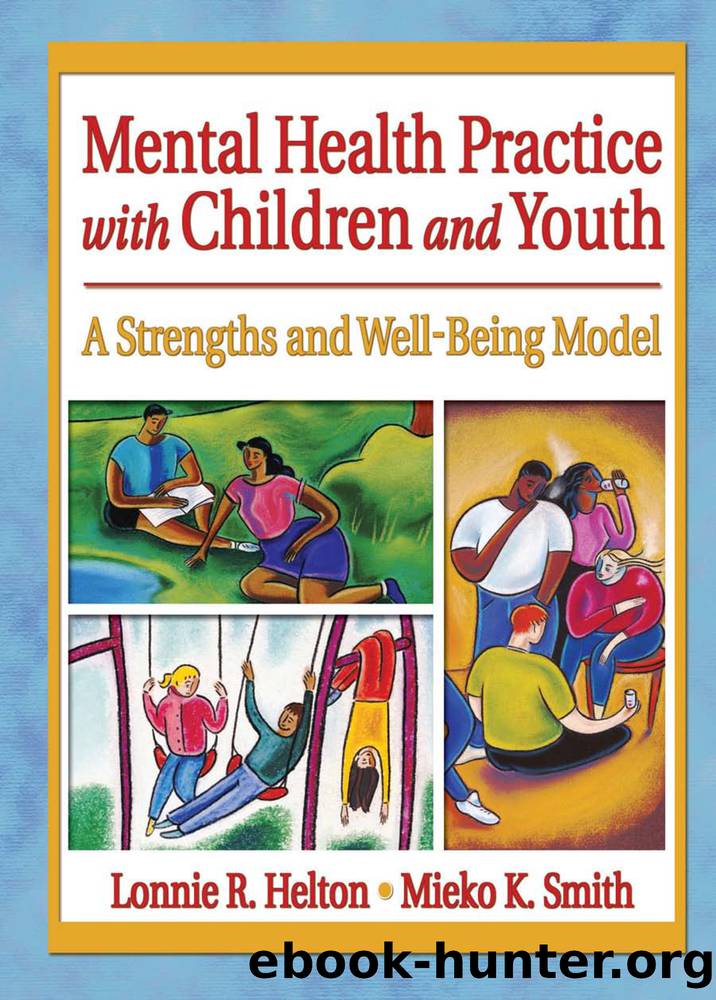Mental Health Practice with Children and Youth by unknow

Author:unknow
Language: eng
Format: epub
Publisher: Taylor & Francis Group
Published: 2022-08-15T00:00:00+00:00
Adolescent Ethnic and Racial Identity
Identity formation in adolescence is an expected developmental hurdle, yet it can be more challenging for children who belong to a minority culture. Minority youth may assume a negative identity if they accept the stereotypes put upon them by members of dominant groups as well as their own ethnic group (Erikson, 1968). Marcia (1980) states that successful identity formation is achieved when one explores his or her ethnic identity and then commits to it. Minority adolescents need to feel a sense of self-satisfaction in order to feel good about themselves within the context of their ethnic group and society. Phinney and Alipura (1992) found that nonwhite children who have seriously examined their ethnic identity and its implications have a better self-image than do those who have not resolved these issues.
Adolescents who experience ongoing bicultural conflict may have difficulty managing dual skills and thus get âcaught or stuck in a transitional stateâ (Robbins, Chatterjee, and Canda, 1998). This may lead to a state of transitional marginality, which Robbins, Chatterjee, and Canda (1998) describe as a state involving acculturation stress brought about by competing interests, values, and behavioral choices in the social situation, âaccompanied by emotional discomfort and cognitive dissonance experienced by the individualâ (p. 137). Ethnic minority children are much more affected by transitional states as they attempt to master the transition to adulthood, as well as forming their ethnic identity in the midst of the transition to a bicultural identity as an adolescent. However, adolescents generally resolve transitional marginality as they develop an ego-syntonic identity and behaviors that meet with social approval (Robbins, Chatterjee, and Canda, 1998).
Ethnic and racial group identity among adolescents is even more important at this time in history, as America's population is becoming increasingly multicultural, multiracial, and multilingual. Almost one-third of the adolescents in the United States belong to an ethnic group, such as African Americans, Asian Americans, Latinos, Jewish Americans and American Indians (Phinney, 1990). Ethnic identity formation has been divided into three phases, in which youngsters begin to identify with and appreciate their ethnic heritage. Phase one generally involves the belief that ethnic identity is not an important personal issue. In the second phase, young people begin to explore the personal impact of their ethnic heritage in an effort to learn more about themselves and their culture. In the final phase, these young people achieve a distinct self-concept, which combines that of their ethnic group and U.S. culture (Phinney, 1989).
A major component of self-concept comes from what other people tell us about ourselves (Uba and Huang, 1999). Minority adolescents seem to be more concerned with racial and ethnic identity than European-American adolescents are, largely due to racism, oppression, and social injustice in their everyday lives. Some ethnic and racial groups seem to be more at risk than others. For instance, Hispanic females are twice as likely as African-American and non-Hispanic white females to attempt suicide (CDC, 1996). This phenomenon is thought to be related to factors such as low self-image
Download
This site does not store any files on its server. We only index and link to content provided by other sites. Please contact the content providers to delete copyright contents if any and email us, we'll remove relevant links or contents immediately.
Unwinding Anxiety by Judson Brewer(72700)
The Art of Coaching by Elena Aguilar(52869)
The Fast Metabolism Diet Cookbook by Haylie Pomroy(21038)
Rewire Your Anxious Brain by Catherine M. Pittman(18516)
Healthy Aging For Dummies by Brent Agin & Sharon Perkins RN(16983)
Talking to Strangers by Malcolm Gladwell(13171)
The Art of Thinking Clearly by Rolf Dobelli(10167)
Mindhunter: Inside the FBI's Elite Serial Crime Unit by John E. Douglas & Mark Olshaker(9144)
Crazy Rich Asians by Kevin Kwan(9144)
The Compound Effect by Darren Hardy(8769)
Tools of Titans by Timothy Ferriss(8178)
Periodization Training for Sports by Tudor Bompa(8129)
Becoming Supernatural by Dr. Joe Dispenza(8073)
Wonder by R. J. Palacio(7936)
Crystal Healing for Women by Mariah K. Lyons(7841)
Bodyweight Strength Training by Jay Cardiello(7822)
Therapeutic Modalities for Musculoskeletal Injuries, 4E by Craig R. Denegar & Ethan Saliba & Susan Saliba(7675)
Change Your Questions, Change Your Life by Marilee Adams(7596)
Should I Stay or Should I Go? by Ramani Durvasula(7535)
